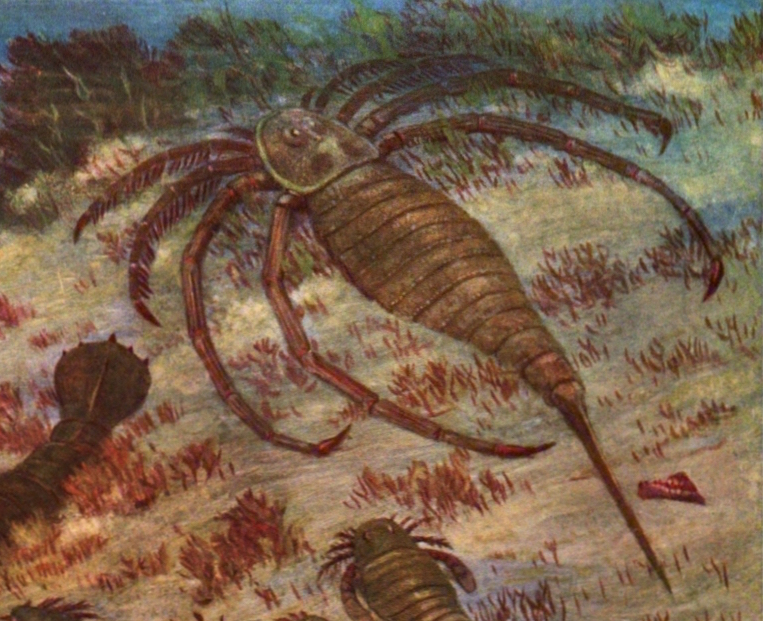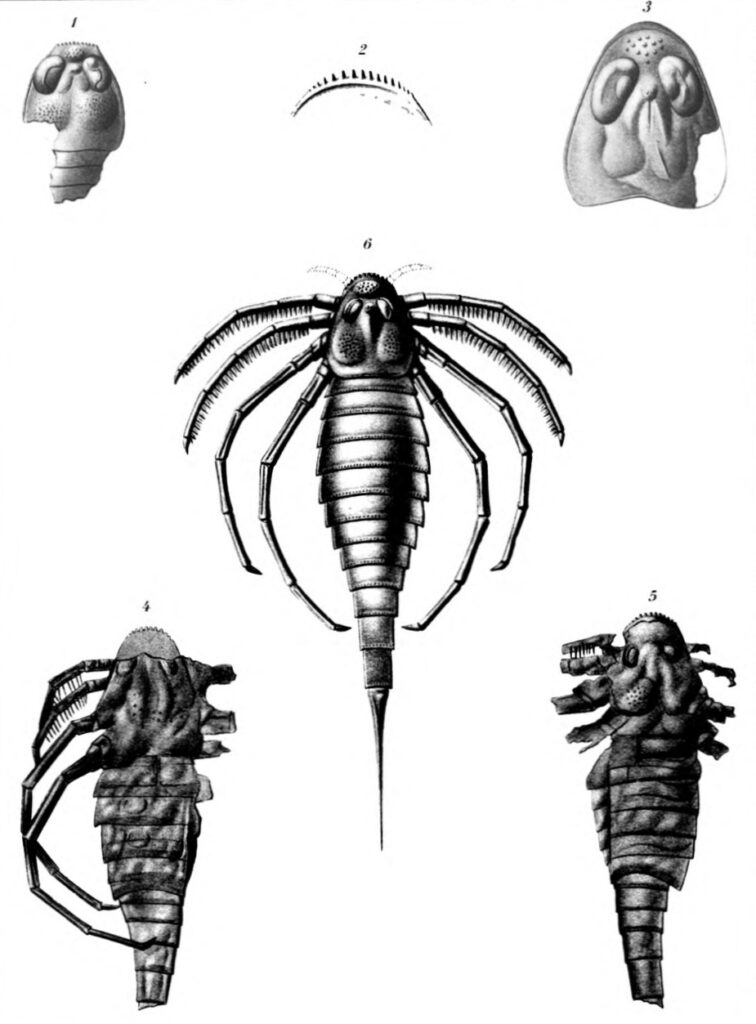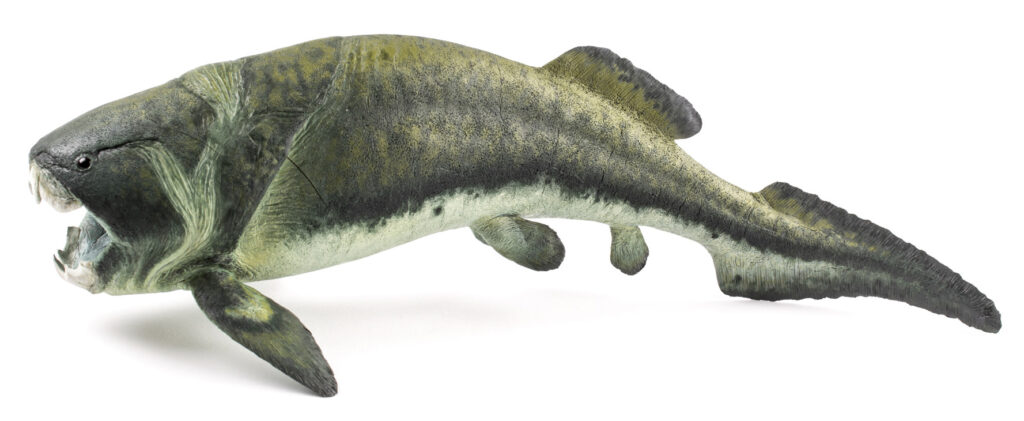Everyone loves sea monsters. Let’s take a look at two real-life sea monsters from the Devonian period (419-359 million years ago), and then talk about how to use them at the table: the hideous spider/crab/scorpion hybrid Sytlonurids and Dunkleosteus, an armored, beaked predatory fish larger than a great white shark.

The Stylonurids were a kind of Eurypterid, an ancient lineage of flat, buglike predators. Most Eurypterids were twenty centimeters long or less, but the biggest currently known, Jaekelopterus rhenaniae, was 2.5 meters long – a little bigger than a bottlenose dolphin! Eurypterids evolved in the ocean, but by the end of their reign, they’d mostly moved into lakes and rivers. Imagine that thing surging up towards you when you go to drink from a pond!
The Stylonurid type of Eurypterids were most notable for their horrifyingly long rear legs, which make the critters look like some sort of awful sea spider. That long, terrible-looking stinger is called a telson. If modern horseshoe crabs are any indication, Stylonurids probably just used their telsons to right themselves when flipped upside down. You’ll see some websites claiming the telson may have delivered a venomous sting, but I haven’t seen any evidence to support that claim. Stylonurids scuttled around on the bottoms of shallow bodies of water; by the end of the Devonian, they were limited exclusively to fresh water. Some of these fresh water bubbas were over a meter long, and just as predatory as their ocean-going kin. They probably grabbed anything that moved and scavenged anything that didn’t – like modern crabs, except enormous and freaky.

Stylonurids were a little unusual among Eurypterids in that they never evolved the ability to swim. About three quarters of known species of Eurypterids had rear legs that looked like paddles, which they could use to swim through the water and chase fish. Stylonurids never developed those paddles. Nonetheless, the non-swimming Eurypterids outlived all their free-swimming counterparts, and were still alive and kicking well over a hundred million years after that dolphin-sized (and free-swimming) Jaekelopterus died out. Lots of folks think about evolution as creating more complex forms that replace the older, simpler forms, but that’s just not the case. Eurypterids are a great case study. Here, just scuttling along on the bottom was a better way to go than developing fancy swimming paddles.

Even as the oceans were filling up with horrifying Eurypterids, a new type of living thing was evolving: fish. These ancient fish didn’t look much like modern ones. One group in particular was covered in armor plating, and had these awful beaked mouths. An old idea in paleontology is that these fish evolved armor as a protection against the Eurypterids that preyed upon them. As the fish got bigger and more heavily-armored, the Eurypterids got bigger and more heavily-armed. It’s a hard idea to test, of course, but if true, this evolutionary arms race ultimately produced one of the nastiest creatures of the Devonian period: the armored predator Dunkleosteus.
Where the Stylonurids were creepy, Dunkleosteus was powerful. Estimates put this thing at up to nine meters long. For context, the biggest great white shark ever spotted was around seven meters long. Dunkleosteus’ bite was one of the strongest ever calculated, rivaling a Tyrannosaurus. After all, the fish swam in an ocean full of creatures that had evolved hard shells (not unlike its own), and this predator needed to be able to chomp through the shells of its prey. It didn’t even have teeth! Its jaws had sharp edges, and formed a sort of fanged beak. Check out its skull, below!

We only know about Dunkleosteus from fossils of its front half. Its back half was probably not armored (otherwise at least one of the fossils we have should have been accompanied by fossilized tail armor), but we can’t say that for sure. Extrapolating from relatives with more complete fossils, Dunkleosteus was probably a strong swimmer, but may not have been particularly agile. Its heavy armor (five centimeters thick in places) likely prevented Dunkleosteus from moving the front half of its body horizontally, so the monster fish’s agility – especially its horizontal agility – would have depended heavily on its rear fins, which haven’t been preserved.
–
So let’s say you want to use these monsters in a cool combat at your table! First, the Stylonurids. Lacking pincers or large mouths, they probably didn’t kill their prey before starting to feed. So give these guys a grapple attack where they latch onto a target (and pin it down if it’s smaller than they are) and start dealing damage every turn they remain latched on. Stylonurids probably weren’t social, but they probably were opportunists, so if one attacks a PC, there may be plenty more not far behind. Throw a dozen meter-long aquatic hell spiders at your party, and they may be in for a fun fight!
The Dunkleosteus is a whole other kettle of fish (excuse the pun). With those jaws, you can give it a bite attack that ignores a heck of a lot of armor. Videos of sharks attacking large prey suggests Dunkleosteus probably bites down hard, swims off to avoid being bitten itself, swims back to see if the prey is dead, and repeats as necessary. Dunkleosteus’ thick head armor should negate most attacks while it’s approaching and attacking, but not against attacks made while it’s swimming away. PCs who dodge that initial bite should be able to attack the fish’s comparatively vulnerable flanks as it leaves to come around for another pass. Because of Dunkleosteus’ (possibly) limited horizontal agility, clever PCs may try playing matador, scooting aside at the last moment to land a blow as the fish goes sailing past. It’s hard to do while swimming, but if they have some sort of mechanical assistance, this bullfighting strategy might be a good one to defeat this monstrous beast.
Image of Dunkleosteus is released under a Creative Commons Attribution-Share Alike 3.0 Unported license. Image is courtesy of Matteo De Stefano of the Italian MuSe science museum.
Image of Dunkleosteus skull is courtesy of the Smithsonian Institute






